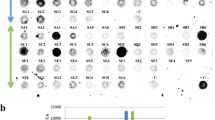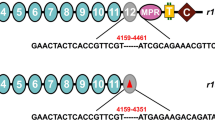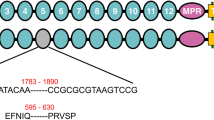Abstract
The Bacillus thuringiensis (Bt) crystal toxins are safe biological insecticides, but have short persistence and are poorly effective against pests that feed inside plant tissues. Production of effective levels of these proteins in plants has required resynthesis of the genes encoding them.We report that amplification of an unmodified crylA(c) coding sequence in chloroplasts up to ∼ 10,000 copies per cell resulted in the accumulation of an unprecedented 3–5% of the soluble protein hi tobacco haves as protoxin. The plants were extremely toxic to larvae of Hetiothis virescens, Helicoverpa zea, and Spodoptera exigua. Since the plastid transgenes are not transmitted by pollen, this report has implications for containment of Bt genes in crop plants. Furthermore, accumulation of insecticidal protein at a high level will facilitate improvement in the management of Bt resistant insect populations.
This is a preview of subscription content, access via your institution
Access options
Subscribe to this journal
Receive 12 print issues and online access
$209.00 per year
only $17.42 per issue
Buy this article
- Purchase on Springer Link
- Instant access to full article PDF
Prices may be subject to local taxes which are calculated during checkout
Similar content being viewed by others
References
Hofte, H. and Whiteley, H.R. 1989. Insecticidal crystal proteins of Bacillus thuringiensis. Microbiol. Rev. 53: 242–255.
Schnepf, H.E., Wong, H.C. and Whiteley, H.R. 1987. Expression of a cloned Bacillus thuringiensis crystal protein gene in EschericHia coli. J.Bacteriol. 169: 4110–4118.
Obukowicz, M.G., Perlak, F.J., Kusano-Kretzmer, K., Mayer, E.J. and Watrud, L.S. 1986. Integration of the delta-endotoxin gene of Bacillus thuringiensis into the chromosome of root-colonizing strains of pseudomonads using Tn5. Gene 45: 327–331.
Vaeck, M. et al. 1987. Transgenic plants protected from insect attack. Nature 328: 33–37.
Adang, M.J. et al. 1987. In: Molecular strategies for crop protection, UCLA symposia on molecular and cellular biology,. 345–353.
Fischhoff, D.A. et al. 1987. Insect tolerant tomato plants. Bio/Technology 5: 807–813.
Perlak, F.J., Fuchs, R.L., Dean, D.A., McPherson, S.L. and Fischhoff, D.A. 1991. Modification of the coding sequence enhances plant expression of insect control protein genes. Proc.Natl. Acad. Sci. USA 88: 3324–3328.
Murray, E.E., Rocheleau, T., Eberle, M., Stock, C., Sekhar, V. and Adang, M.J. 1991. Analysis of unstable RNA transcripts of insecticidal crystal protein genes of Bacillus thuringiensis in transgenic plants and electroporated protoplasts. Plant Mol. Biol. 16: 1035–1050.
Adang, M.J., Brody, M.S., Cardineau, G., Eagan, N., Roush, R.T., Shewmaker, C.K., Jones, A., Oakes, J.V. and McBride, K.E. 1993. The reconstruction and expression of a Bacillus thuringiensis crylllA gene in protoplasts and potato plants. Plant Mol.Biol. 21: 1131–1145.
Gray, M.W. 1993. Origin and evolution of organelle genomes. Current Opinion in Genetics and Development. 3: 884–890.
Palmer, J.D. 1990. Contrasting modes and tempos of genome evolution in land plant organelles. Trends in Genetics 6: 115–120.
Shimada, H. and Sugiura, M. 1991. Fine structural features of the chloroplast genome: comparison of the sequenced chloroplast genomes. Nucl.Acids Res. 19: 983–995.
Bendieh, A.J. 1987. Why do chloroplasts and mitochondria contain so many copies of their genome?. BioEssays 6: 279–282.
Staub, J.M. and Maliga, P. 1993. Accumulation of Dl porypeptide in tobacco plastids is regulated via the untranslated region of the psbA mRNA. EMBO J. 12: 601–606.
McBridge, K.E., Schaaf, D.J., Daley, M. and Stalker, D. 1994. Controlled expression of plastid transgenes in plants based on a nuclear DNA-encoded and plastid-targeted T7 RNA polymerase. Proc. Natl. Acad.Sci. USA 91: 7301–7305.
Carrer, H., Hockenberry, T.N., Svab, Z. and Maliga, P. 1993. Kanamycin resistance as a selectable marker for plastid transformation in tobacco. Mol.Gen. Genet. 241: 49–56.
Svab, Z. and Maliga, P. 1993. High-frequency plastid transformation in tobacco by selection for a chimeric aadA gene. Proc.Natl.Acad.Sci.USA 90: 913–917.
Macintosh, S. C., et al. 1990. Specificity and efficacy of purified Bacillus thuringiensis proteins against agronomically important species.J. Invertebr.Pathol. 56: 258–266.
Moar, W.J., Masson, L., Brousseau, R. and Trumble, J.T. 1990. Toxicity to Spodoptera exigua and Trichoplusia ni of individual Pl protoxins and sporulated cultures of Bacillus thuringiensis subsp. kurstaki HD-1 and NRD-12. Appl Environ Microbiol. 56: 2480–2483.
Beegle, C.C., Lewis, L.C., Lynch, R.E. and Martinez, A.J. 1981. Interaction of larval age and antibiotic on the susceptibility of three insect species to Bacillus thuringiensis. J. Invert. Pathol. 37: 143–153.
Maliga, P. 1993. Towards plastid transformation in flowering plants. TIBTECH. 11: 101–107.
Wong, E.Y., Hironaka, C.M. and Fischhoff, D.A. 1992. Arabidopsis thaliana small subunit leader and transit peptide enhance the expression of Bacillus thuringiensis proteins in transgenic plants. Plant Mol. Biol. 20: 81–93.
Weising, K., Schell, J. and Khal, G. 1988. Foreign genes in plants: transfer, structure, expression, and applications. Ann. Rev. Genet. 22: 421–477.
Roush, R.T. 1994. Managing pests and their resistance to Bacillus thuringiensis: can transgenic crops be better than sprays? Biocontrol science and Technology. 4: 501–516.
Kareiva, P. 1993. Transgenic plants on trial. Nature 363: 580–581.
Gould, F. and Anderson, A. 1991. Effects of Bacillus thuringiensis and HD-73 delta-endotoxin on growth, behavior, and fitness of susceptible and toxin-adapted strains of Heliothis virescens (Lepidoptera: Noctuidae) Environmental Entomology. 36: 289–300.
Adang, M.J. et al. 1985. Characterized full-length and truncated plasmid clones of the crystal protein of Bacillus thuringiensis subsp. kurstaki HD-73 and their toxicity to Manduca sexta. Gene 36: 289–300.
Zoubenko, O.V., Allison, L.A., Svab, Z. and Maliga, P. 1994. Efficient targeting of foreign genes into the tobacco plastid genome. Nucl. Acids Res. 22: 3819–3824.
Author information
Authors and Affiliations
Rights and permissions
About this article
Cite this article
McBride, K., Svab, Z., Schaaf, D. et al. Amplification of a Chimeric Bacillus Gene in Chloroplasts Leads to an Extraordinary Level of an Insecticidal Protein in Tobacco. Nat Biotechnol 13, 362–365 (1995). https://doi.org/10.1038/nbt0495-362
Received:
Accepted:
Issue Date:
DOI: https://doi.org/10.1038/nbt0495-362
This article is cited by
-
Chloroplast genomes: diversity, evolution, and applications in genetic engineering
Genome Biology (2016)
-
Chloroplasts: state of research and practical applications of plastome sequencing
Planta (2016)
-
Transplastomic plants for innovations in agriculture. A review
Agronomy for Sustainable Development (2015)
-
Construction of Novel Chloroplast Expression Vector and Development of an Efficient Transformation System for the Diatom Phaeodactylum tricornutum
Marine Biotechnology (2014)
-
Transgene-induced pleiotropic effects in transplastomic plants
Biotechnology Letters (2014)



